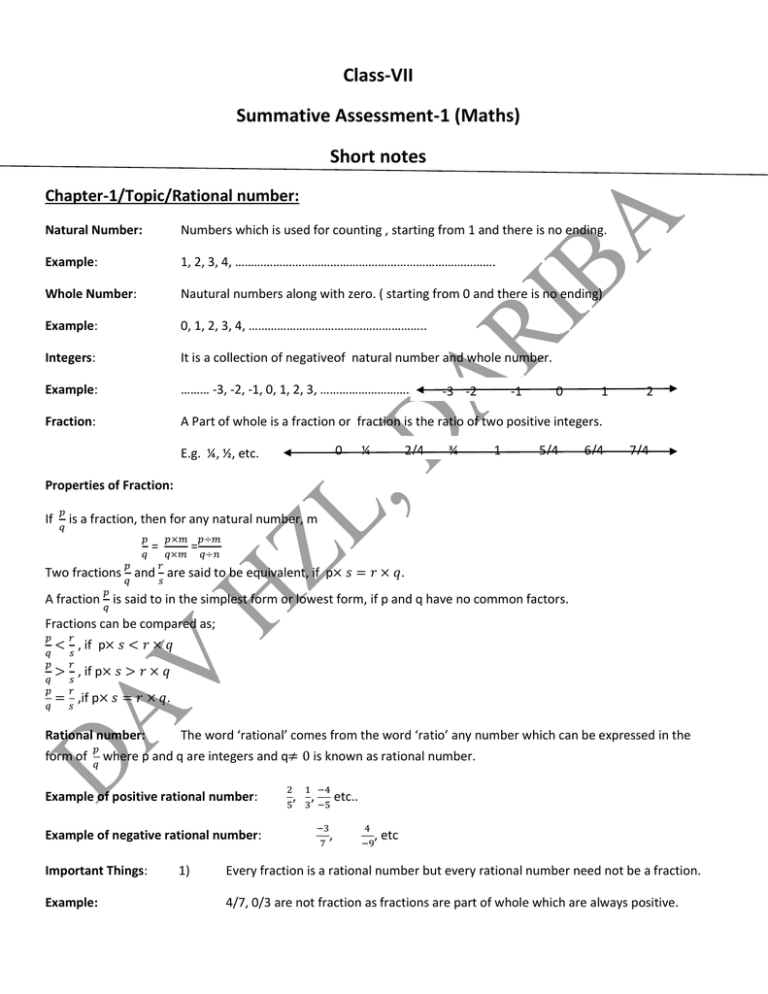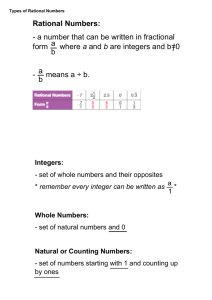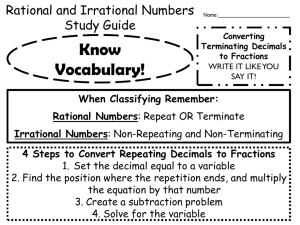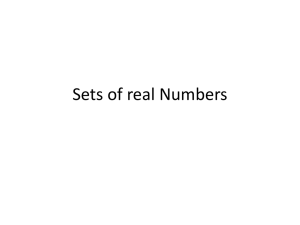Mathematics
advertisement

Class-VII
Summative Assessment-1 (Maths)
Short notes
Chapter-1/Topic/Rational number:
Natural Number:
Numbers which is used for counting , starting from 1 and there is no ending.
Example:
1, 2, 3, 4, ……………………………………………………………………….
Whole Number:
Nautural numbers along with zero. ( starting from 0 and there is no ending)
Example:
0, 1, 2, 3, 4, ………………………………………………..
Integers:
It is a collection of negativeof natural number and whole number.
Example:
……… -3, -2, -1, 0, 1, 2, 3, ……………………………….. -3 -2
-1
0
1
3
A Part of whole is a fraction or fraction is the ratio of two positive integers.
Fraction:
0
E.g. ¼, ½, etc.
¼
2/4
¾
1
5/4
6/4
2
7/4
Properties of Fraction:
If
𝑝
𝑞
is a fraction, then for any natural number, m
𝑝
𝑞
𝑝
𝑞
=
𝑝×𝑚
𝑞×𝑚
𝑝÷𝑚
= 𝑞÷𝑛
𝑟
𝑠
Two fractions and are said to be equivalent, if p× 𝑠 = 𝑟 × 𝑞.
𝑝
A fraction 𝑞 is said to in the simplest form or lowest form, if p and q have no common factors.
Fractions can be compared as;
𝑝
𝑞
𝑝
𝑞
𝑝
𝑞
𝑟
< 𝑠 , if p× 𝑠 < 𝑟 × 𝑞
𝑟
> 𝑠 , if p× 𝑠 > 𝑟 × 𝑞
𝑟
= 𝑠 ,if p× 𝑠 = 𝑟 × 𝑞.
Rational number:
form of
𝑝
𝑞
The word ‘rational’ comes from the word ‘ratio’ any number which can be expressed in the
where p and q are integers and q≠ 0 is known as rational number.
Example of positive rational number:
Example of negative rational number:
Important Things:
Example:
1)
2 1 −4
, ,
5 3 −5
−3
,
7
etc..
4
,
−9
etc
Every fraction is a rational number but every rational number need not be a fraction.
4/7, 0/3 are not fraction as fractions are part of whole which are always positive.
2)
Example:
Every integers is a rational number but every rational need not be integers.
-1/2, 1/3 are not integers. But 2, 3 are rational numbers.
Comparing Rational number:
By representing on number line.
Left rational is less than right rational number on number line.
0 ¼
2/4
¾
1
5/4
6/4
7/4
0 is least and 7/4 is greatest .
Without representing on number line:
i)
If two rational numbers have the same positive denominators,
the number with the larger numerator will be greater than the one with smaller numerator.
2
5
Example:
ii)
4
is less than 5 here denominator is same and larger numerator is 5.
If two rational numbers have different denominators, then first make denominators equal and their compare.
2
5
Example: Compare which is greater
Solution:
2
5
=
3
4
or
Make denominator same with taking LCM of 5 and 4=20
2×4
8
= 20
5×4
3
4
,
3×5
4×5
=
15
20
=
Now, we can see both rational denominator s 20 which is same so larger numerator greater rational number.
15
20
8
2
It gives only positive value of any rational number. It is indicated as | |
Absolute value:
Example:
3
is greater than 20 that means 4 >5
Absolute value of -3 or |−3| =3,
|7| =7
Chapter-2/Topics/Operation on rational numbers
Addition of two rational numbers:
Case 1: When the rational numbers have the same denominator:
then divide or write common denominator.
Example:
7
11
+
6
11
=
7+6
11
=
Add numerator of the rational numbers and
13
11
Case 2: When the rational numbers have different denominators:
Take the L.C.M. of denominator to make
some denominator then do the same process as we have done in case 1.
Example:
3,9=9
7
5
+3
9
here denominators are different , firstly we make denominator the same by taking LCM of
7
9
5×3
7
+ 3×3 = 9 +
15
9
=
7+15
9
=
22
9
Properties of addition of rational numbers:
The sum remains the same even if we change the order of addends, for two rational numbers x and y, x+y=y+x
This property is called commutative property e.g. 8+6=6+9=15
Sum of three rational numbers remain the same even after changing the groups of the addends, if x, y, and z are three
rational numbers, then (x+y)+z=x+(y+z) or (2+3)+7=2+(3+7)=12.
This property is known as ‘Associative law of addition’.
When 0 is added to any rational number, the sum is the rational number itself, x+0=x ( 0 is called additive identity).
Every rational number has an additive inverse such that their sum equal to zero, if x is rational number, then –x is a
−7
rational number such that x+(-x) =0, -x is called additive inverse. E.g. additive inverse of 5 is -5. Additive inverse of 31
7
is 31.
Subtraction of rational numbers:
Case 1: When the rational numbers have the same denominator:
and then divide or write common denominator.
Example:
7
11
−
6
11
=
7−6
11
=
Subtract numerator of the rational numbers
1
11
Case 2: When the rational numbers have different denominators:
Take the L.C.M. of denominator to make
some denominator then does the same process as we have done in case 1.
Example:
7
9
5
− 7 here denominators are different, firstly we make denominator the same by taking LCM of
7×7
5×9
− 7×9
9×7
7,9=63
Corollary:
49
45
= 63 − 63 =
49−45
63
4
= 63
Properties does not exist as we have seen in addition.
Multiplication of rational numbers:
𝑎
𝑏
𝑐
𝑑
If and are two rational numbers t hen their product is given by
𝑎
𝑏
𝑐
𝑎𝑐
𝑃𝑟𝑜𝑑𝑢𝑐𝑡 𝑜𝑓 𝑛𝑢𝑚𝑒𝑟𝑎𝑡𝑜𝑟𝑠 𝑜𝑓 𝑟𝑎𝑡𝑖𝑜𝑛𝑎𝑙 𝑛𝑢𝑚𝑏𝑒𝑟
x 𝑑 = 𝑏𝑑 =𝑃𝑟𝑜𝑑𝑢𝑐𝑡 𝑜𝑓 𝑑𝑒𝑛𝑜𝑚𝑖𝑛𝑎𝑡𝑜𝑟𝑠 𝑜𝑓 𝑟𝑎𝑡𝑖𝑜𝑛𝑎𝑙 𝑛𝑢𝑚𝑏𝑒𝑟
Example:
7
4
9
63
× 6 = 24
Properties of multiplication of rational numbers:
Product of two rational numbers remains the same even if we change their order, i.e. if x and y are rational numbers,
then 𝑥 × 𝑦 = 𝑦 × 𝑥 [e.g. 2x3=3x2=6]. This is commutative law of multiplication.
Product remains the same even when we change the grouping of rational numbers, if x, y, and z are rational numbers,
then (𝑥 × 𝑦) × 𝑧 = 𝑥 × (𝑦 × 𝑧) [(3x4)x5=3x(4x5)=60]. This is associative law of multiplication.
Product of a rational number and zero is zero. If x is any rational number, then𝑥 × 0 = 0 × 𝑥 = 0.
One multiplied by any rational number is the rational number itself, if x is a rational number,
Then 𝑥 × 1 = 1 × 𝑥 = 𝑥. i.e. 1 is the multiplicative identity.
If x, y and z are rational numbers, then
𝑥 × (𝑦 + 𝑧) = 𝑥 × 𝑦 + 𝑥 × 𝑧
ii) 𝑥 × (𝑦 − 𝑧) = 𝑥 × 𝑦 − 𝑥 × 𝑧
This is distributive law of multiplication.
Reciprocal or multiplicative inverse of rational number:
𝑎
𝑏
The non-zero numbers 𝑏 and 𝑎 is reciprocals of each other.
Example1:
The reciprocal of
3
5
is
5
3
,
Example 2:
The reciprocal of
−7
3
is
−3
7
.
Important facts about reciprocal:
Zero has no reciprocal.
The reciprocal of 1 and -1 are remain same.
Division of rational number: Dividing one rational number by another rational number except zero is the same as
the multiplication of the first by the reciprocal of the second rational number. i.e. 𝑥 ÷ 𝑦 = 𝑥 × 𝑦 −1
𝑎
𝑏
𝑐
𝑎
𝑑
𝑐
𝑑
÷ 𝑑 = 𝑏 × 𝑐 {𝑤ℎ𝑒𝑟𝑒
≠ 0}
Property of division for rational number does not exist.
Examples:
Solution:
Divide
7
21
÷ 26
13
7
13
7
21
by 26
21
7
26
2
= 13 × (26)−1 =13 × 21
=
2
3
3
Chapter-3/Topics/ Rational numbers as decimals
Rational numbers as decimals:
Any fraction having denominator as 10 or a power of 10 (10, 100, 1000, 1000 etc.) can be easily presented in decimal
form.
e.g.
1
10
= 0.1,
237
100
= 2.37 etc.
shift decimal from right that much zero of denominator.
Important facts: if we want to change rational number into decimal, then multiply 2 by5, 4 by 25, 8 by 125, 16 by
625 etc.
2x5=10, 4x25=100, 8x125=1000 and 16x625=10000.
7
2
Example:
convert
into decimal without actual division.
Solution:
here denominator is 2,
7×5
2×5
35
10
=
= 3.5
Conversion of rational numbers into decimals by long division method.
Every rational number can be represented in the form of decimal by using long division method. The representation
can be terminating or non-terminating.
We divide numerator by denominator and remainder comes less than divisor, put decimal in quotient put and put 0
right of dividend, again divide continue the same process till the remainder comes zero.
Decimal
Terminating decimal: we get
zero as remainder, when we
divide any numerator by
denominator or denominator
in the form of 2m5n, where m
and n are positive integers.
Non-Terminating decimal: We did not
get zero remainder when we divide any
numerator by denominator; its
denominator is not in the form of 2m5n
Example; 23.363669……….
Example: 2.3, 3.567, etc
Conversion of terminating decimals into rational numbers:
We remove decimal putting zero in numerator and
denominator (If numerator contain figures after decimal, then we put zero in denominator after digits of number and
vice-versa)
We understand by examples
Example:
Like decimal:
Example:
12
2.3367
1025
1.2=100, 2.3367= 10000 , 1.025=1000,
2
3.029
2000
= 3029 etc.
After decimal number of figures are same.
4.53, 7.03, 6.23 etc.
Unlike decimal: After decimal number of figures are not same.
Example:
3.75, 3..256, 3.2598 etc.
How to make like decimals from unlike decimals:
decimals from unlike decimals.
Examples:
decimal.
We put zero last figure of decimal as we need to make like
2.34, 7.564 Here after decimal two figures in first decimal number and three figures in second
Now, we can write 2.34=2.340, 7.564 become like decimals.
We can not put zero any where (between 3 and 4, 5 and 6) to make like decimals only we can put zero after last figure
of decimal numbers.
Addition of decimals: It can only possible in like decimals. First of all we make like decimals while doing sum of any
decimal numbers.
Example:
2.37+0.356+.7896+6.045=
Subtraction of decimals:
like decimals.
Example:
We can subtract only in like decimals, so first of all make sure all decimals should be
8.02369-7.356=
452.367-600.35=
Multiplication of decimals:
We multiply as know the process. Then count figures after decimal in all decimal
numbers then put decimal from right that much counted figures.
Example:
75.36 x 63.78=4806.4608 [ two figures after decimal in first decimal number and two figures
in second decimal as well so two number of figure should be4 after decimal ]
Chapter-5/Topics/Application of percentage
Percentage:
It is a type of fraction where denominator is 100 or per hundred.
Conversion:
5
1
Percentage into fraction.
E.g.
5%=100=20
Percentage into decimal:
E.g.
5%=100=0.05
Fraction or ratio into percentage:
E.g.
3:5 = x100%=60%
Decimal into percentage:
E.g. 0.23x100%=23
5
3
5
Cost price:
Amount which we give to purchase something. It is represented as C.P.
Selling price:
Amount which we take to sell something. It is represented as S.P.
Principal:
it is original money or sum by which earn money
Amount:
it is sum of money of principal and interest.
Formula:
1
100
E.g 1%=
Profit= Selling price- Cost price (S.P. > C.P.)
Loss= Cost price – Selling price (C.P. > S.P.)
Profit %=
Loss %=
𝑝𝑟𝑜𝑓𝑖𝑡
𝑐𝑜𝑠𝑡 𝑝𝑟𝑖𝑐𝑒
𝑙𝑜𝑠𝑠
𝑐𝑜𝑠𝑡 𝑝𝑟𝑖𝑐𝑒
× 100
× 100
Selling price=Cost price x (
Selling price= Cost price x(
Cost price=
Cost price=
100+𝑝𝑟𝑜𝑓𝑖𝑡%
100
100−𝑙𝑜𝑠𝑠%
100
Time(t)=
)
100×𝑠𝑒𝑙𝑙𝑖𝑛𝑔 𝑝𝑟𝑖𝑐𝑒
(100+𝑝𝑟𝑜𝑓𝑖𝑡%)
100×𝑠𝑒𝑙𝑙𝑖𝑛𝑔 𝑝𝑟𝑖𝑐𝑒
(100−𝑙𝑜𝑠𝑠%)
𝑝𝑟𝑖𝑛𝑐𝑖𝑝𝑎𝑙 ×𝑟𝑎𝑡𝑒×𝑡𝑖𝑚𝑒(𝑖𝑛 𝑦𝑒𝑎𝑟)
Simple Interest(SI)=
Rate(r)=
)
100
𝑠𝑖𝑚𝑝𝑙𝑒 𝑖𝑛𝑡𝑒𝑟𝑒𝑠𝑡 ×100
𝑝𝑟𝑖𝑛𝑐𝑖𝑝𝑎𝑙 ×𝑡𝑖𝑚𝑒(𝑖𝑛 𝑦𝑒𝑎𝑟
𝑠𝑖𝑚𝑝𝑙𝑒 𝑖𝑛𝑡𝑒𝑟𝑒𝑠𝑡 ×100
𝑝𝑟𝑖𝑛𝑐𝑖𝑝𝑎𝑙 ×𝑟𝑎𝑡𝑒
Amount=principal + simple interest
Chapter-8/Topics/The triangle and its properties
Triangle:
It is simple closed figure made up of three line segments is called triangle.
Kinds of triangles (according to their sides)
i.
ii.
iii.
Equilateral triangle:
Isosceles triangle:
Scalene triangle:
All sides and angles are equal.
Two sides and its opposite angles are equal.
All sides and angles are unequal.
Kinds of triangles (according to their angles)
i.
ii.
iii.
Acute angle triangle: Each angle of triangle is acute.
Obtuse angle triangle: At most one angle of triangle is obtuse.
Right angle triangle: At most one angle of triangle is right angle.
Exterior angles of triangle:
The exterior angle is equal to the sum of the two interior opposite angles.
Angle sum property:
Sum of the angles of triangle is 1800
Triangular inequality:
side.
The sum of the lengths of any two sides of a triangle is greater than the length of third
Medians:
opposite side.
A median of a triangle is the line segment that joins a vertex to the mid-point of the
Centroid of the triangle:
Altitudes:
perpendicular to
Orthocentre:
triangle.
All the medians of triangle intersect at point is called centroid of the triangle.
An altitude of a triangle is the line segment from a vertex of the triangle,
the opposite side.
The point of occurrence of the altitudes of a triangle is called the orthocenter of the
Circumcentre:
The point of concurrence of the perpendicular bisectors of the sides of a triangle is
called the circumcentre of the triangle.
Incentre:
The angle bisectors of a triangle will all lie in the interior of the triangle, the incentre
of a triangle always lies in its interior.
Chapter-10/Topics/Construction of triangles
Introduction:
An exterior angle of triangle
equals the sum of two interior
opposite angles
The sum of three angles of
a triangle is 1800
A closed figure
in a plane having
3 sides and 3
angles is called
a triangle.
The sum of any two sides
of a triangle is greater than
the third side.
Note: A triangle can be uniquely determined when three independent components are known.
Construction of triangles when three sides are given:
Draw a triangle ABC, AB=6cm, BC=7cm, CA=5.5cm
AB+CA> BC
Draw a line segment AB= 6cm.(we can draw any line segments)
With B as centre and radius 7cm, draw an arc.
With A as centre and radius 5.5cm, draw another arc intersecting the previous at C.
Join AB and AC to obtain the desire triangle ABC.
Construction of a triangle with two sides and the included angle given:
(SAS Triangle construction)
Example:
Construct a triangle AOB given that OA=5cm, OB=4.5cm and ⎳AOB=500.
Steps of Construction:
Step 1:
Draw a line OA of 5cm.
Step 2:
Now at point O, make an angle ⎳XOB=500.
Step 3:
Keep your compass at O and make an arc of 4.5cm on line OX.
Step 4:
Name the intersection of line and the arc as A
Step 5:
Join AB, Thus triangle OAB is the required triangle.
Chapter-13/Topics/Symmetry
Symmetry:
A figure is called symmetrical about a line, if when it is folded about that line, the two parts of the
figure coincide with each other. See below stars and arrow are symmetry.
Dotted lines in arrow represent line of symmetry.
Lines of symmetry about English Alphabets (Capital):
Consider the following three alphabets
Important facts:
Line of symmetry of a line segment is its perpendicular bisector.
Thus, an angle is symmetric about the line which bisects this angle and the bisector of the angle is its line (or
axis) of symmetry.
Thus, a rectangle has only two lines of symmetry.
A rhombus, therefore, has two lines of symmetry, namely its diagonal.
Each regular polygon has as many lines of symmetry as it has sides.
A line has infinitely many lines of symmetry.
One part is the mirror reflection of the other.
A circle has infinitely many lines of symmetry. In fact each diameter of a circle is its line of symmetry.
Class-VII
Mathematics
Summative assessment -2 short notes
Chapter -4/Topics/Exponent and powers
Laws of exponents:
Let a and b any two rational numbers and let m and n be integers , then we have,
i)
amxan=am+n
ii)
𝑎𝑚
𝑎𝑛
ii)
(𝑎𝑚 )𝑛 = 𝑎𝑚𝑛 = (𝑎𝑛 )𝑚
iv)
(𝑎𝑏) 𝑛 = 𝑎𝑛 𝑏 𝑛
iii)
( )𝑛 =
v)
( )−𝑛 = ( )𝑛
𝑎
𝑏
𝑎𝑛
𝑏𝑛
, b≠ 0
𝑚
= 𝑎𝑚−𝑛 , a≠ 0
𝑎
𝑏
𝑏
𝑎
1
Positive rational number as exponent:
𝑎 𝑛 = (𝑎𝑚 )𝑛
Negative rational number as exponent:
𝑎− 𝑛 =
𝑚
1
1
(𝑎𝑚 )𝑛
Examples:
𝟕𝟓
𝟕𝟔
Extra questions:
(𝟒)𝟔 × (𝟐)𝟕 =(𝟐×𝟐)𝟔 × (𝟐)𝟕 =(𝟐𝟐)𝟔 × (𝟐)𝟕 =(𝟐)𝟐×𝟔 × (𝟐)𝟕 =(𝟐)𝟏𝟐 × (𝟐)𝟕 =(𝟐)𝟏𝟐+𝟕 =(𝟐)𝟏𝟗
𝟗
𝟏
= 𝟕𝟓−𝟔 = 𝟕−𝟏 = 𝟕 [𝟕−𝟏 ≠ −𝟕 ]
𝟑
𝟑×𝟑
𝟑
𝟑𝟐
𝟑
𝟑
𝟑
𝟑
𝟑
𝟑
𝟑
Chapter-6/Topics/Algebraic Expression
Algebraic expression: An expression in which contains algebraic terms with operations
OR
Combination of terms(combination of variable and constants)
E.g. x+y+z, x2+y3+z4 +4 etc.
Monomials:
Algebraic expression which has single term.
Binomials:
Algebraic expression which has two terms.
Trinomials:
Algebraic expression which has three terms.
Like terms:
Those terms whose variables are same. E.g. 2x, 3x
Unlike terms:
Those terms whose variables are not same E.g. 5x, 5y
Remarks:
Addition and subtraction can possible of algebraic expressions in like terms otherwise not.
Multiplication of monomial and monomial:
First multiply by numeric value or coefficient of monomial then
multiply by variables with the help of law of exponents. E.g. 2abx 3a=6a2b
Multiplication of monomial and binomial:
Breaking binomial into monomial
Chapter-7/Topics/ Linear equation in one variable
The standard form of linear equation in one variable x is ax+b=0, where a and b are rational numbers, a≠ 0.
Examples:
2x+3=4, 7+y=9.
While solving a linear equations:
Add and subtract the same quantity on both sides of an equation.
Multiply both sides of an equation by the same non-zero number.
Divide both sides of an equation by the same non-zero number..
Example:
2x+3=6
2x+3-3=6-3
2x=3
X=3/2
By transposing a term, means simply its sign and taking it to the other side of the equation[ + changes to –(vice-versa),
× changes to ÷]
Finding a solution to a word problem
Formation of an equation
Solving an equation.
Interpreting the solution
Examples:
Anu is four years older than Sunil. Eight years ago, Anu was three times Sunil’s age. Find the ages of
Sunil and Anu.
Solution:
Let the present age of Sunil is to be x years
Present age of Anu will be=x+4
Eight years ago , Sunil’s age=x-8, and Anu’s age =x+4-8=x-4
According to questions:
x-4=3(x-8)
x-4=3x-24 that
Chapter-9/Topic/Congruent Triangles
Congruence:x-3x=-24+4
If two geometrical figures coincide exactly, by placing one over the other, the figures are said to be
congruent to each other. It is denoted as ≅.
-2x=-20
1. Two figures are congruent, if they have exactly the same shape and size.
X=20/2=10
Present age of Sunil is 10 years and present age of Anu is 14years
2.
3.
4.
5.
6.
7.
8.
Two line segments are congruent, if they have the same length.
Two angles are congruent, if they have same measures.
Two squares are congruent, if they have the same side length.
Two rectangles are congruent, if they have the same length and breadths.
Two circles are congruent, if they have the same radii.
Two equilateral triangles are congruent, if they have same measurements of side.
Two triangles are congruent, if three sides and three angles of one triangle are respectively equal to the
corresponding three sides and three angles of the other.
SSS (side-side-side) congruence condition:
Two triangles are congruent if three sides of one triangle are
respectively equal to the three sides of the other.
SAS (side-angle-side) congruence condition:
Two triangles are congruent if two sides and the included angle of one
triangle are respectively equal to the two sides and included angle of the other.
ASA (angle-side-angle) congruence condition: Two triangles are congruent if two angles and the included side of one
triangle are respectively equal the two angles and the included side of the other.
RHS (right-hypotenuse-side) congruence condition:
Two right triangles are congruent if the hypotenuse and one
side of one triangle are respectively equal to the hypotenuse and corresponding side of the other.
CPCT is short form of corresponding parts of congruence triangle. This CPCT is follow when two triangles are
congruent to each other.
Chapter-11/Topics/Perimeter and Area
Perimeter:
The lengths of boundary of a closed figure are called the perimeter.
Area:
The magnitude of a plane region is called its area.
Area of triangle= ½ base x height
Area of equilateral triangle=
√𝟑
𝟒
x (side)2
Perimeter of triangle= sum of all sides
Perimeter of equilateral triangle=3 x sides
Area of rectangle= Length x Breadth
Perimeter of rectangle=2(length+Breadth)
Area of square= Side x Side
Perimeter of square= 4 x Side
Area of Parallelogram = Base x Height
Area of rhombus= Base X height
=1/2 x Length of first diagonal x Second
diagonal
Perimeter= 2 x Sum of adjacent sides
Perimeter=2 x Sum of adjacent sides = 4xsides
𝟏
Area of trapezium=𝟐 x sum of parallel sides x Height
Area of circle= 𝝅 𝒓𝟐 , where r is the radius of circle, 𝝅 =
𝟐𝟐
𝒐𝒓 𝟑. 𝟏𝟒 =The constant ratio of the circumference of
𝟕
a circle to its diameter
Area of a rectangular path inside(or outside) a
rectangular field=Area of the outer rectangle-Area of
the inner rectangle
Chapter: 12/Topics/Data handling
Perimeter = sum of all sides
Perimeter of circle=Circumference of circle=2 𝝅 r
Area of cross path=Area of all the rectangles making the
paths- Area of the common rectangle(or Square)
Data:
It is a collection of numbers gathered to give some information.
Range: It is the difference of the highest and the lowest observation.
𝑆𝑢𝑚 𝑜𝑓 𝑎𝑙𝑙 𝑜𝑏𝑠𝑒𝑟𝑣𝑎𝑡𝑖𝑜𝑛𝑠
Mean= 𝑁𝑢𝑚𝑏𝑒𝑟 𝑜𝑓 𝑜𝑏𝑠𝑒𝑟𝑣𝑎𝑡𝑖𝑜𝑛𝑠
Median: It is the value of a given number of observations which divides it into exactly two parts.
Mode: it is the value of a given number of observations which occur maximum number of times.
Bar Graph: Bar graphs are pictorial representation of data using bars of uniform width and equal spacing between
them.
Chapter:14/Topics/ Visualising solid shapes
Solid Shapes:
Face:
It is three dimensional figures.
it is a plane surface of the solid which is connected with edges
Edge: it is a line-segment at which two faces of the solid meet.
Vertices: It is a point or corner at which edges meet.
Euler’s Formula for polyhedron
F+V= E+2, where F is face , V is the vertices and E is the edges of solid shape(3-d)







